Featured Comment:
“Yes! Finally a recipe that cools all the ingredients. I thought I was crazy to do that. Thanks for the weights. This is now my recipe! Cheers.”
– Bobby G
What is Tempura Batter?
Tempura is a Japanese dish with a long history. It is commonly made with seafood or vegetables coated in a light batter made from a simple mixture of flour, egg, and water, which is then deep-fried.
Despite its world-renowned fame as a Japanese dish, did you know that tempura actually originated from Portugal? It was inspired by a dish called “Peixinhos da Horta” and was introduced to Japan in the 16th century.
Tempura started its journey in Nagasaki Prefecture and eventually spread to the east of Japan, becoming one of the “Three Flavors of Edo (Tokyo).” Before that point, there was no culture of deep frying or cooking with a batter.
It’s interesting to note that Portugal was one of the few countries that Japan traded with at the time, and the influence of Portuguese culture can be seen in other traditional Japanese dishes too. In fact, there are even a number of Japanese words that originated from Portuguese, including the word “tempura” itself, which is believed to come from “tempero” which means “seasoning”.
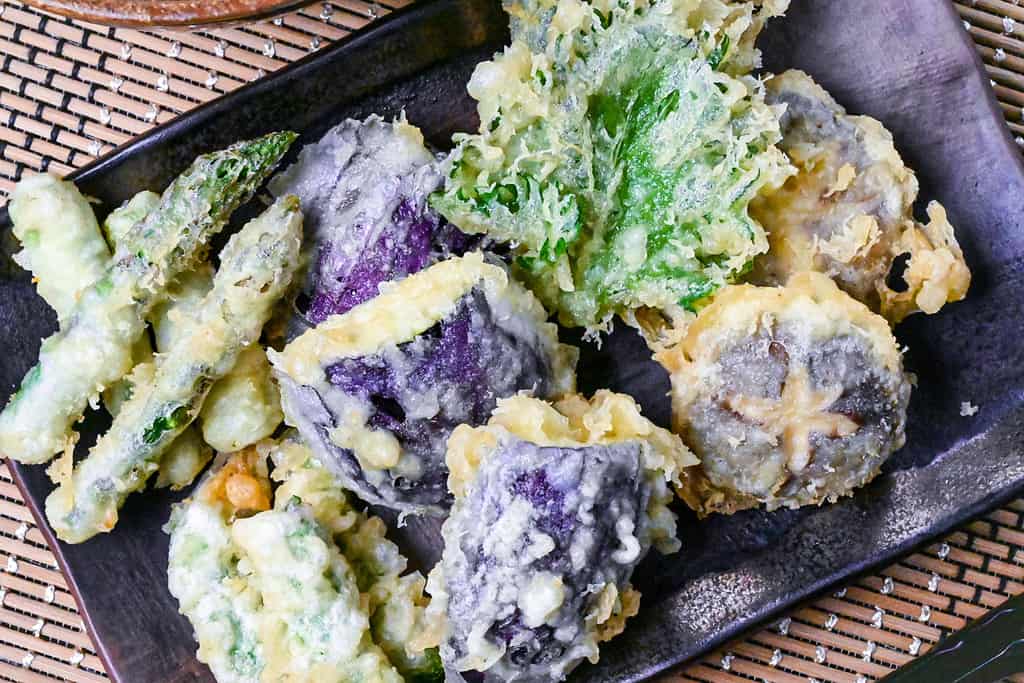
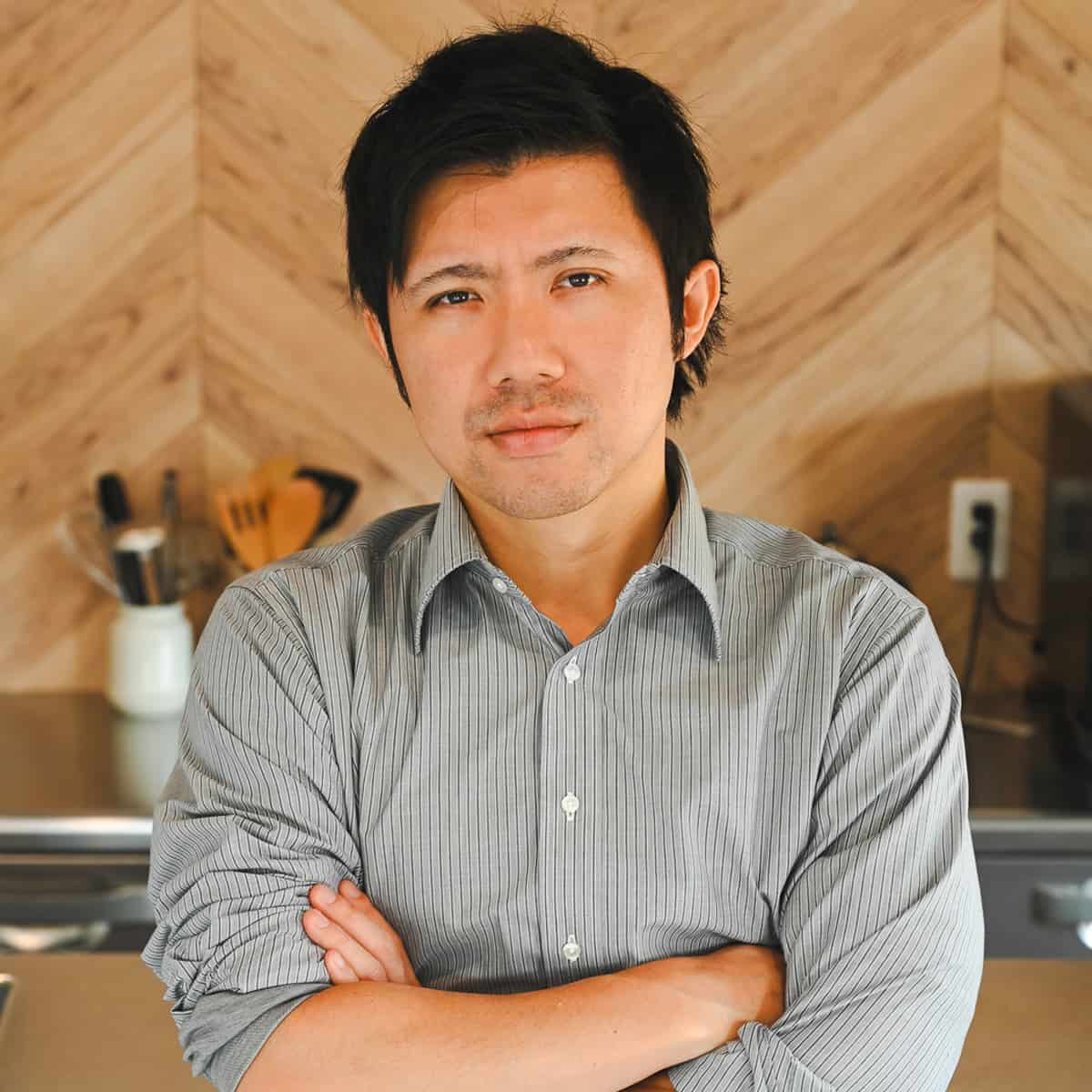
How I Developed This Recipe
There’s no right or wrong way to make tempura batter, and it varies even within Japan. You’ll find different recipes in specialty restaurants versus what you can buy at a supermarket. You’ll often find tempura sold outside of Japan with a thicker, fritter-like batter.
Regardless, I believe the best tempura lets the natural flavors of the ingredients shine through in a thin, crispy batter that doesn’t overpower the dish.
So I’ve developed an authentic batter that resembles that of a high-end tempura restaurant without any added flavors or salt. It can be enjoyed simply with salt or dipping sauce at the end. After a few tries, I finally nailed the light and crispy batter. Give it a go!
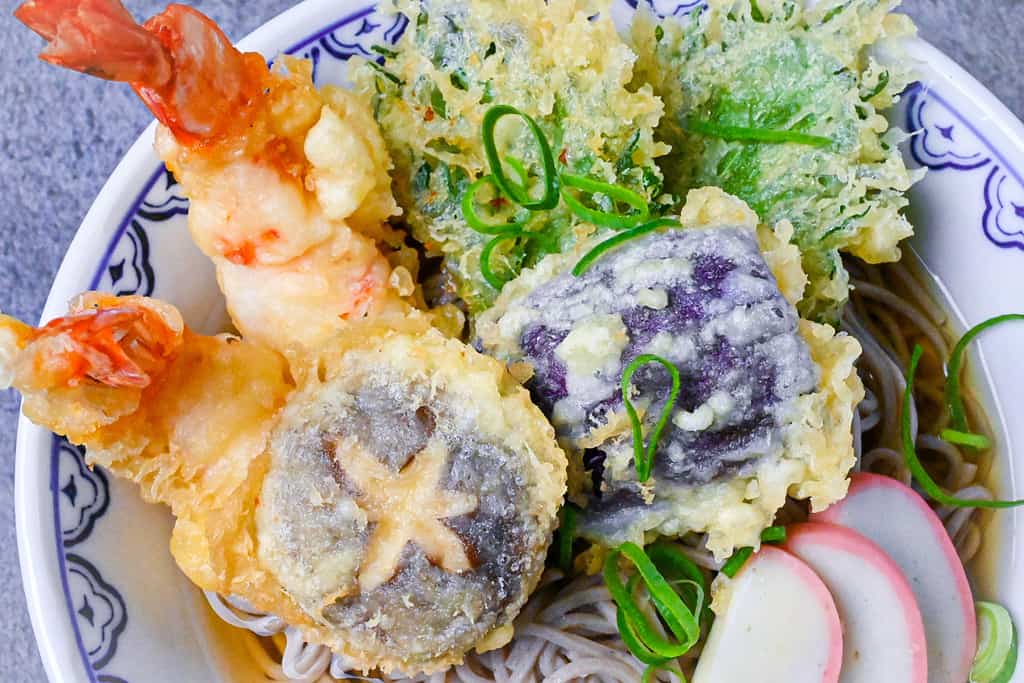
Popular Ingredients to Use for Tempura
The ingredients used for tempura are called “tane” (タネ). Although there is no set rule, tane is mostly seafood or vegetables.
Here is a list of some of the most commonly used “tane” (tempura ingredients) in Japan:
- Shrimp/prawn
- Squid
- Kakiage (mixed vegetable tempura)
- Sweet potato
- Pumpkin
- Conger eel
- Eggplant / Aubergine
- Sand borer
- Lotus roots
- Chicken
The list is based on the ranking done by Livedoor News.
Feel free to click on the links to see my specialized recipes and cooking times for each ingredient. Please note that my chicken tempura recipe uses a slightly different batter than the recipe below.
There is no doubt that shrimp tempura is the king of tempura. I think everyone in Japan would agree. But other than shrimp, my personal favorite is eggplant tempura! How about yours? Let me know your favorite in the comments below!
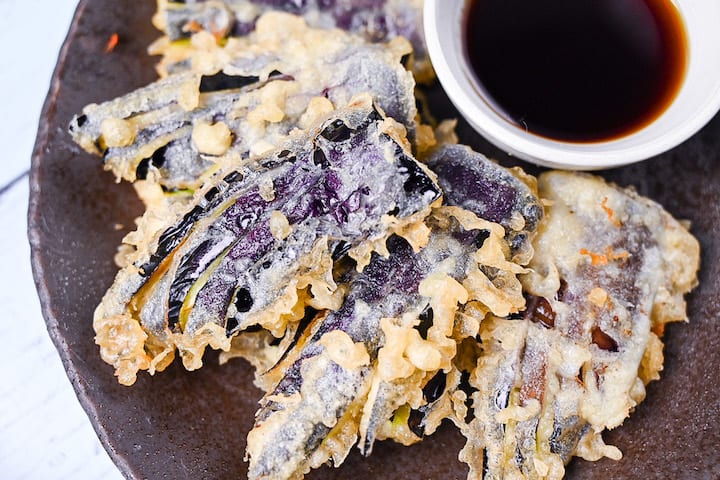
Visual Walkthrough & Tips
Here are my step-by-step instructions for how to make Authentic Japanese Tempura Batter at home. For ingredient quantities and simplified instructions, scroll down for the Printable Recipe Card below.
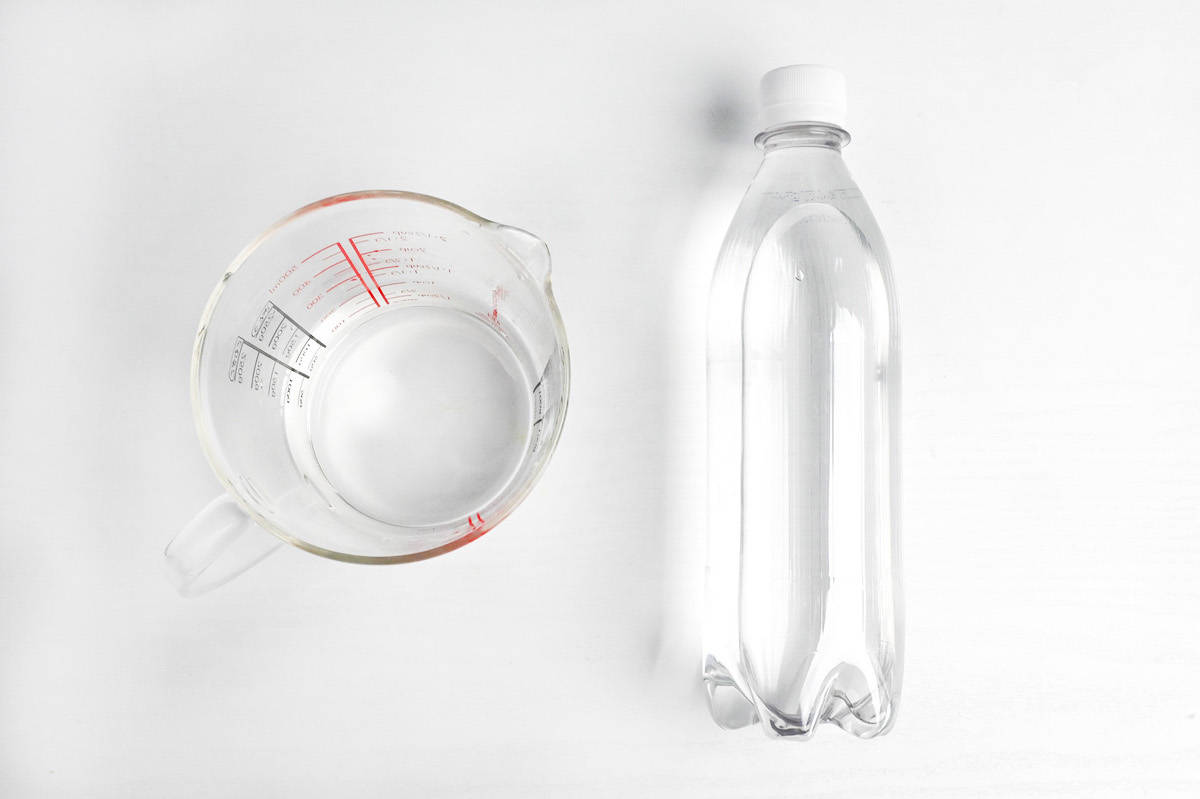
Start by measuring cold water into a jug and putting it in the fridge for about 20-30 minutes. For sparkling water, use a chilled, unopened bottle and measure it out right before making the batter.
To prevent gluten formation in tempura batter, using ice-cold water is crucial. Cold batter mixed at low temperatures delays gluten formation and reacts better with hot oil, resulting in puffier, lighter tempura.
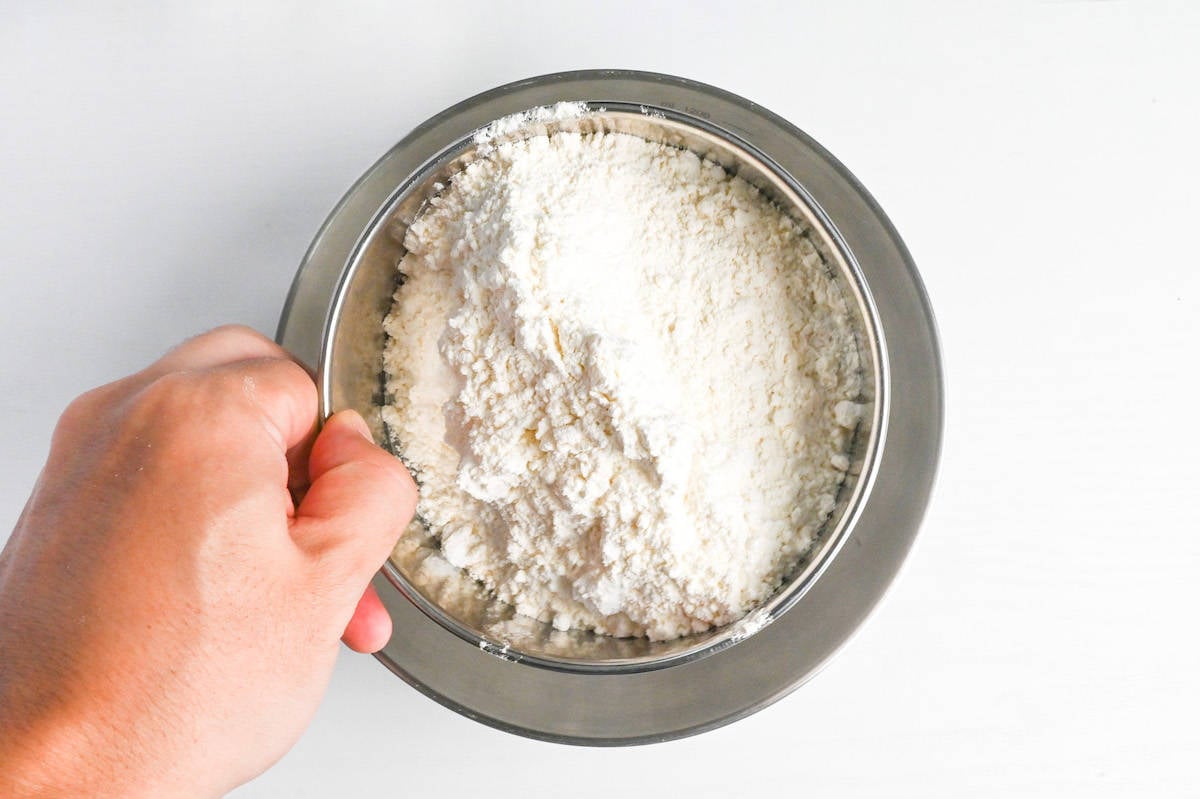
Sift together cornstarch and cake flour in a bowl and give it a good mix. Again, chilling the dry mix helps the tempura get that perfect crispiness. So, into the freezer it goes for 20-30 minutes.
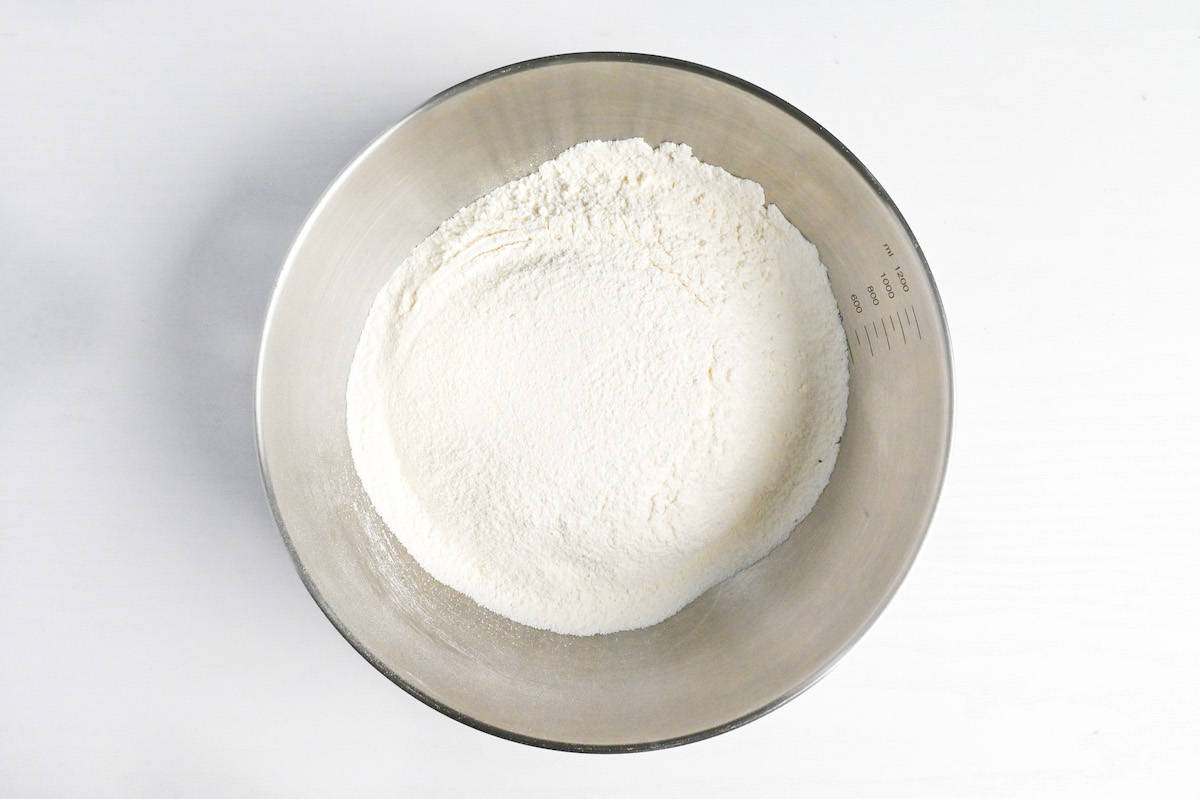
Chilling everything is the key!
For tempura, use low-protein wheat flour like cake flour. Avoid strong flours like bread flour to prevent a sticky and heavy batter.
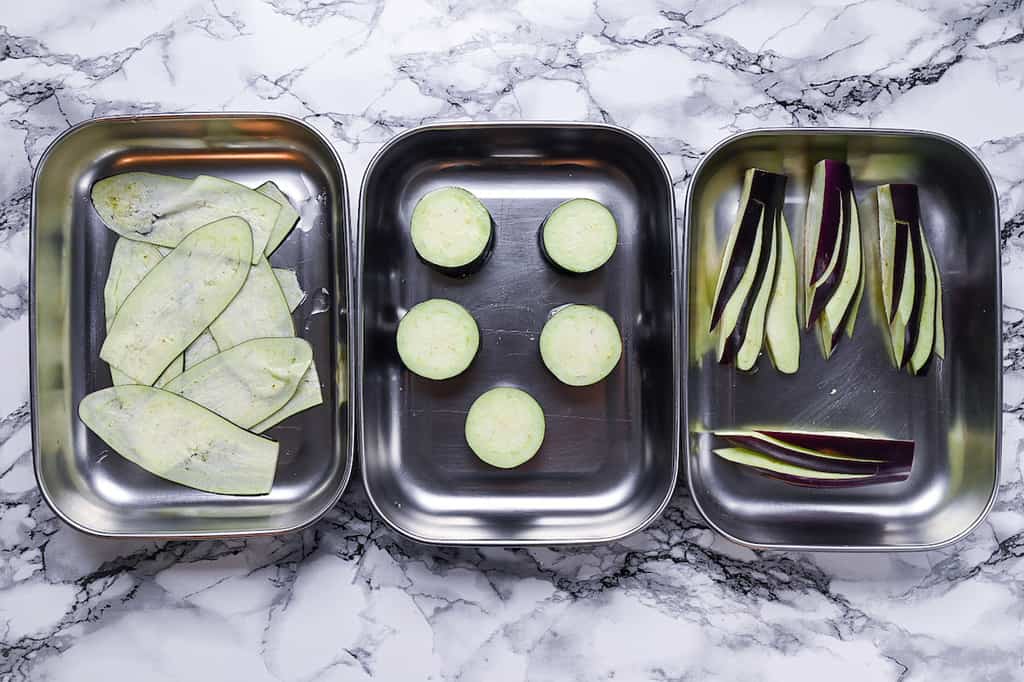
While our mixtures are chilling, let’s get our tempura ingredients ready. Wash, cut, and pat them dry with a paper towel. Trust me, dry ingredients fry better.
I currently have specific instructions for shrimp, eggplant, and sweet potatoes in separate posts.
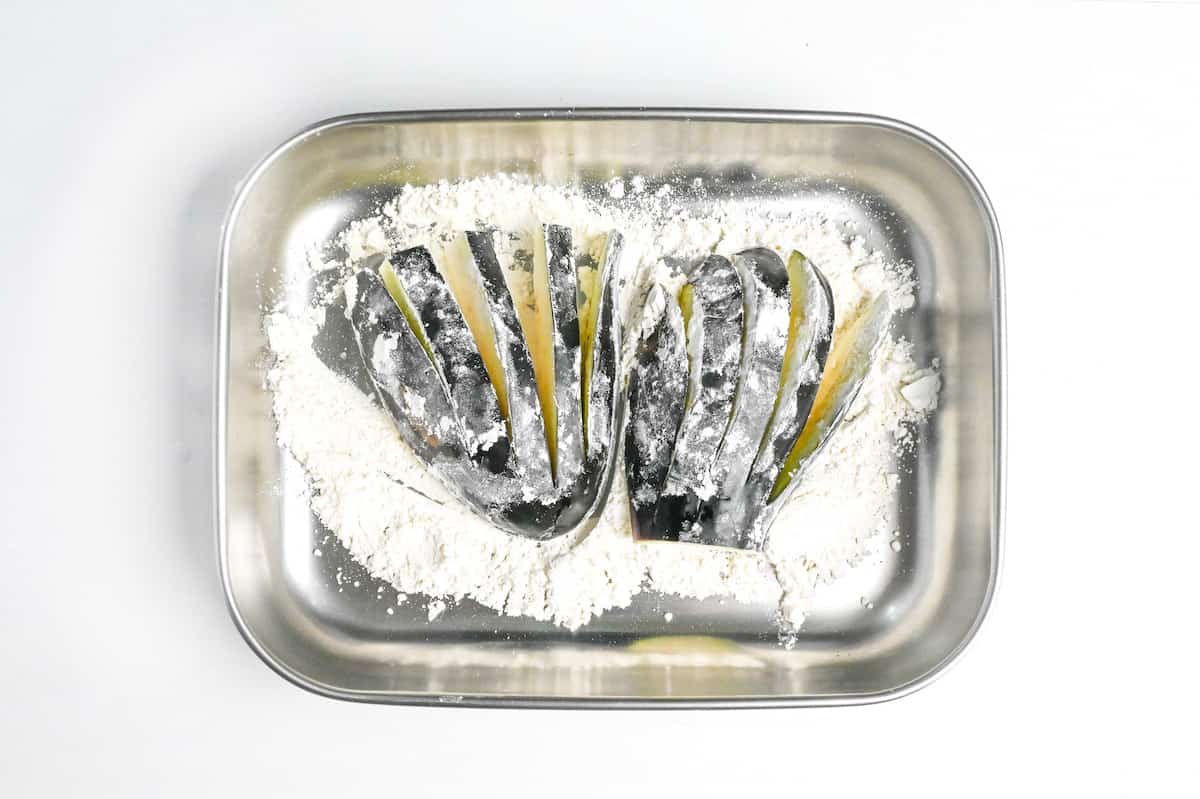
Dry ingredients with kitchen paper and dust with a small amount of flour to help the batter stick.
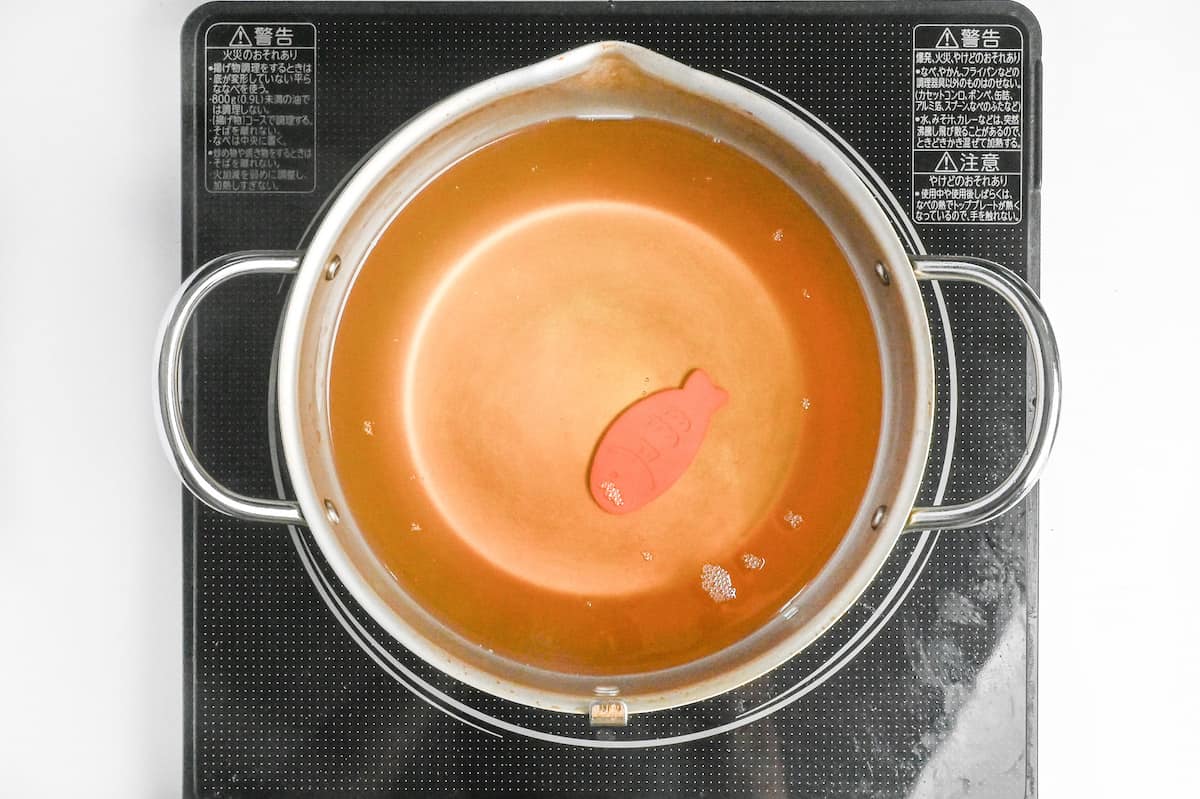
Once everything is thoroughly chilled, it’s time to heat our oil. Aim for a temperature of 180°C (356°F). You might need to adjust the temperature for specific ingredients (check the post above for details).
I highly recommend using a contactless cooking thermometer for accuracy.
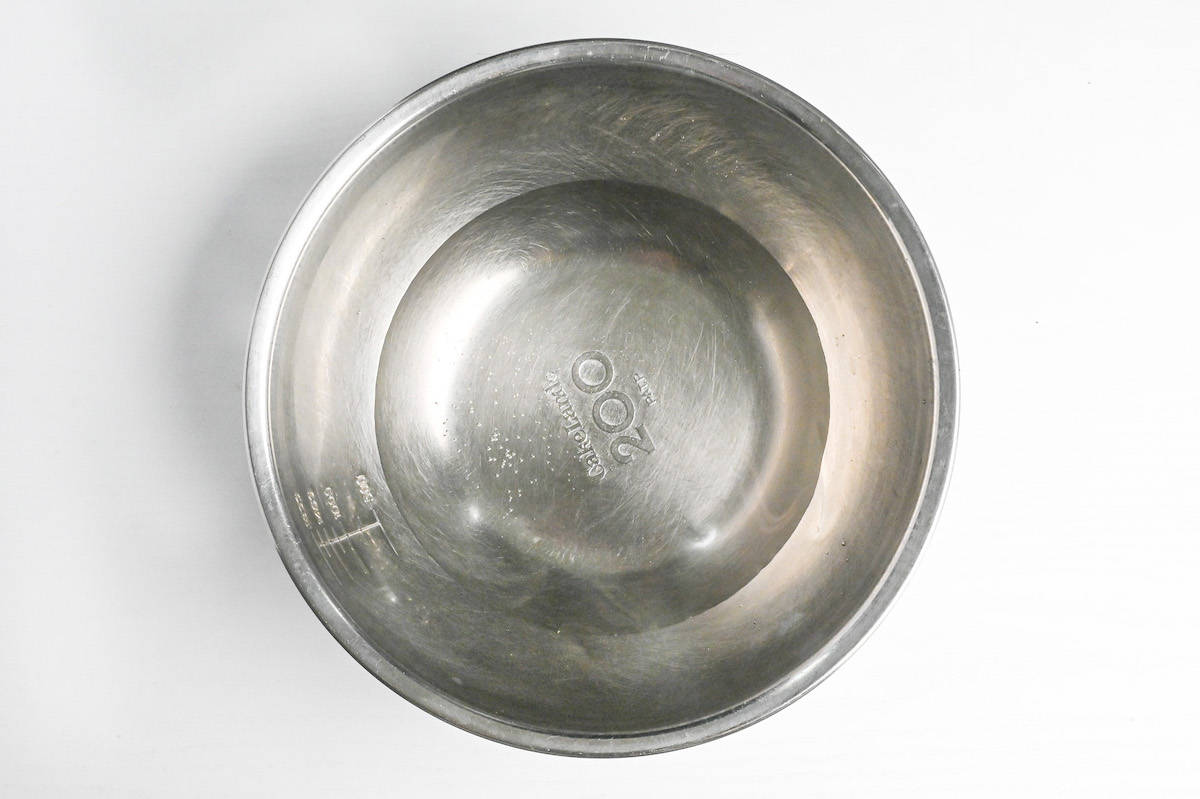
Pour the chilled water and sparkling water into a bowl. Crack in an egg and give it a gentle whisk.
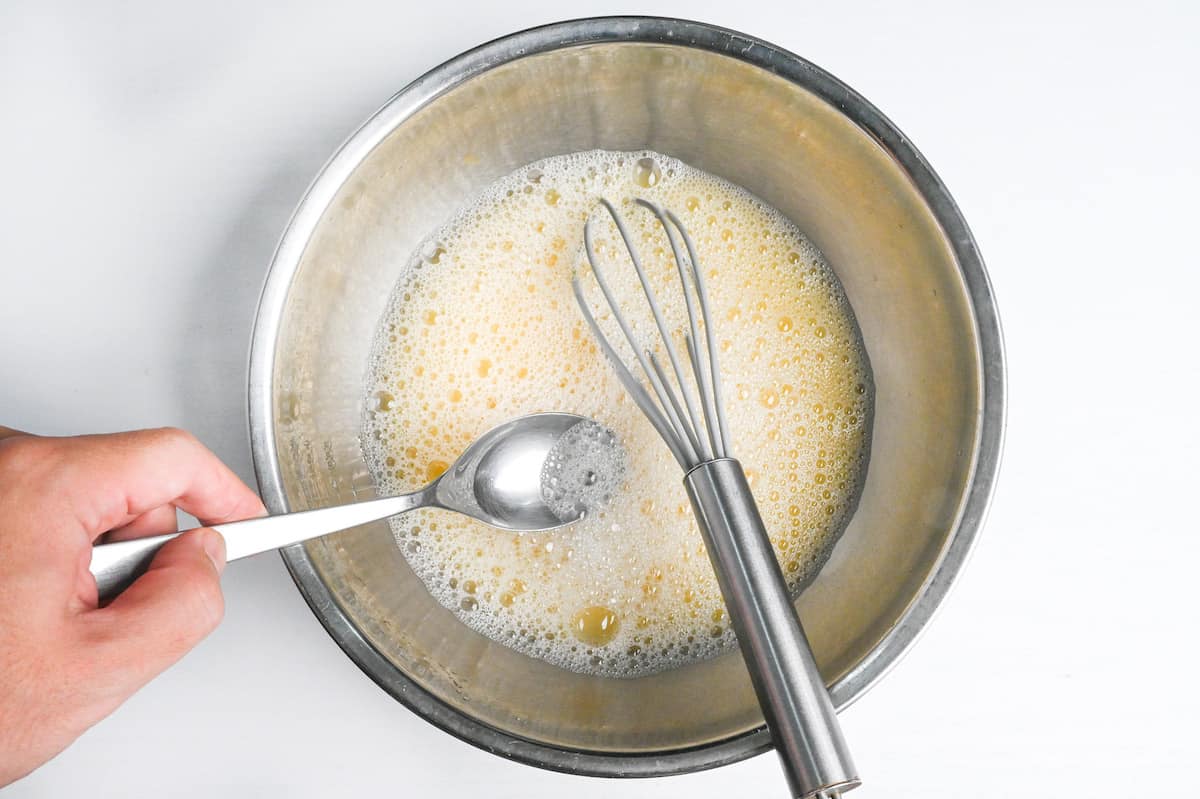
If you see any bubbles or foam, remove this foam with a spoon to prevent stickiness or burning in the batter.
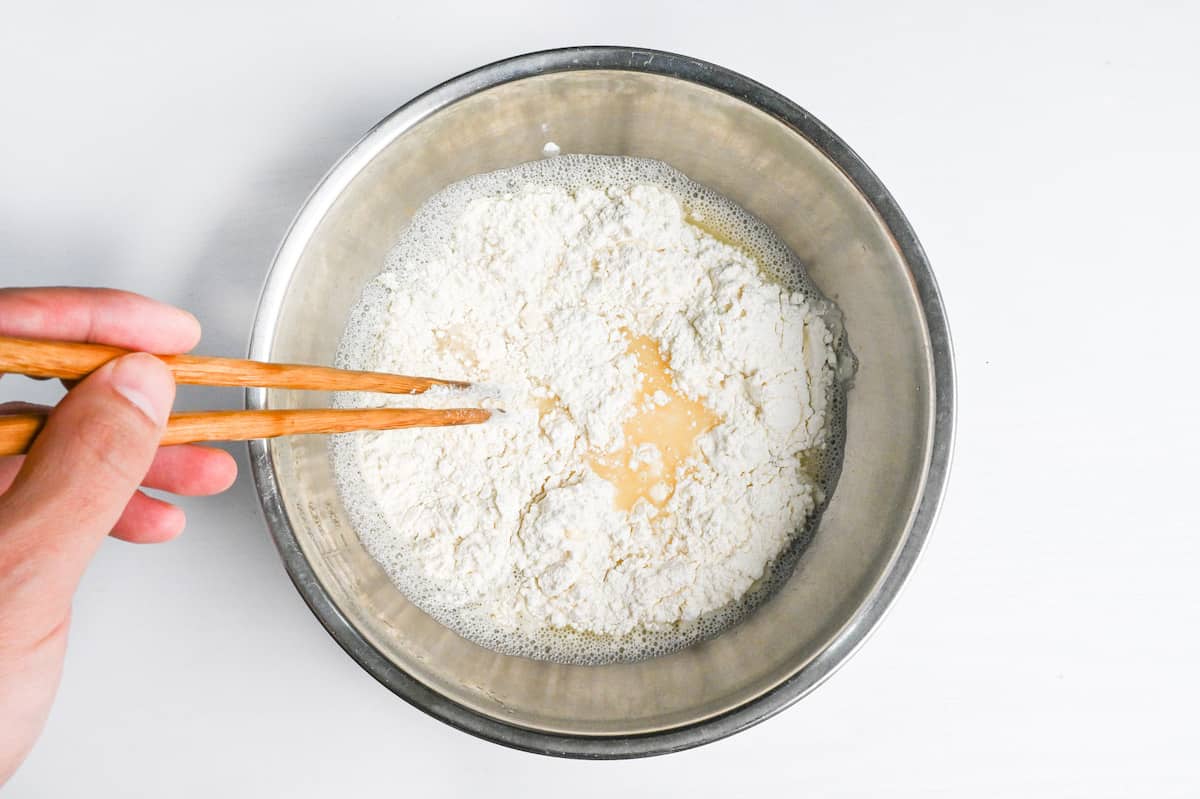
Add the sifted flour and starch in thirds, gently mixing with chopsticks. Remember, no vigorous whisking, as this can start to form gluten. We want a light batter.
For tempura batter, lumps are preferable to a smooth mix. Overmixing causes gluten formation, leading to chewy, not crispy tempura, and it won’t have the desired bubbly appearance. Mix flour and water roughly with chopsticks, not a whisk, and leave some lumps.
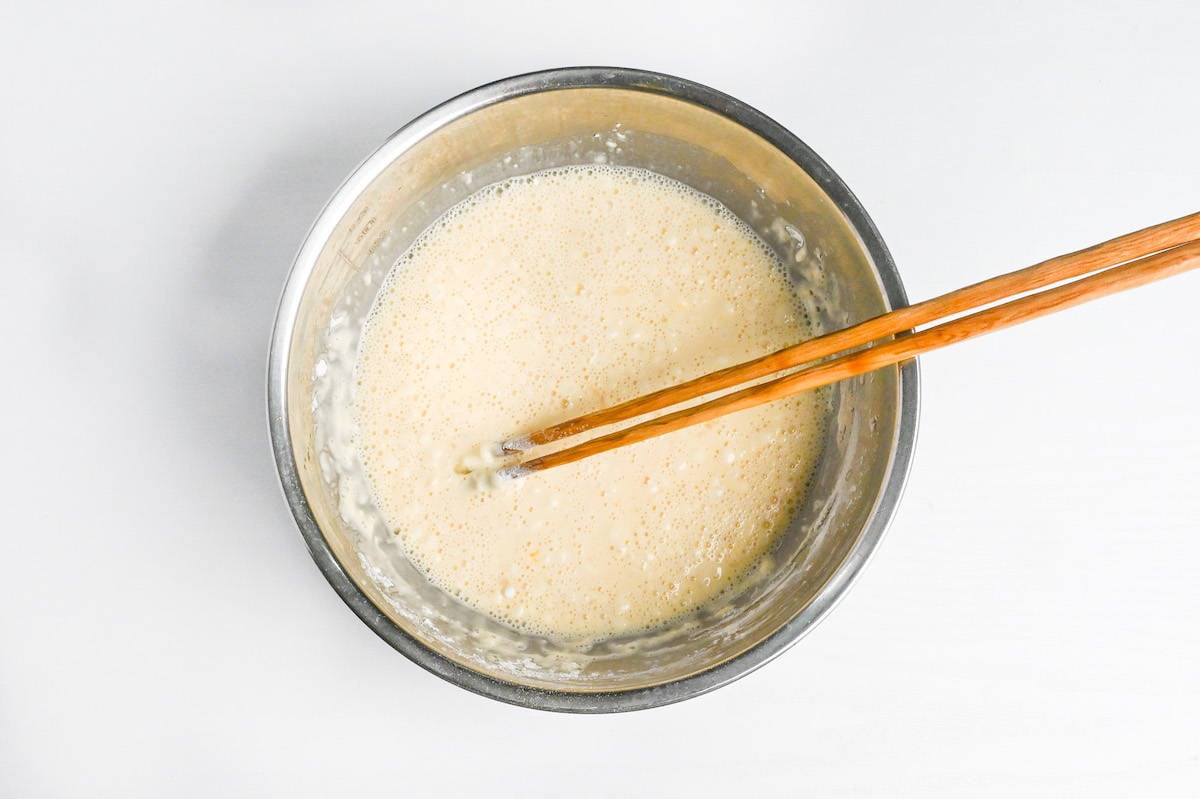
Batter left sitting increases gluten formation, resulting in a chewy, thick tempura. Instead of pre-mixing beforehand, chill ingredients separately and combine right before frying for optimal texture.
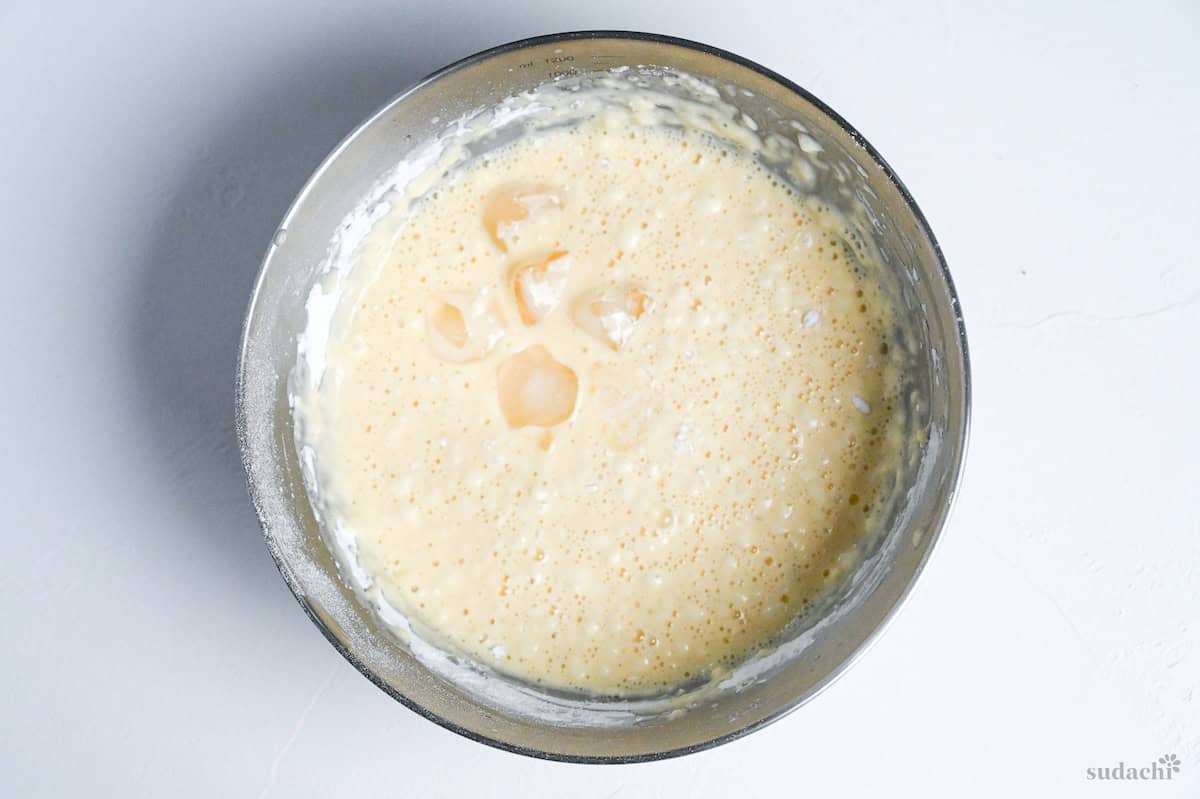
Add ice cubes to keep the batter cold.
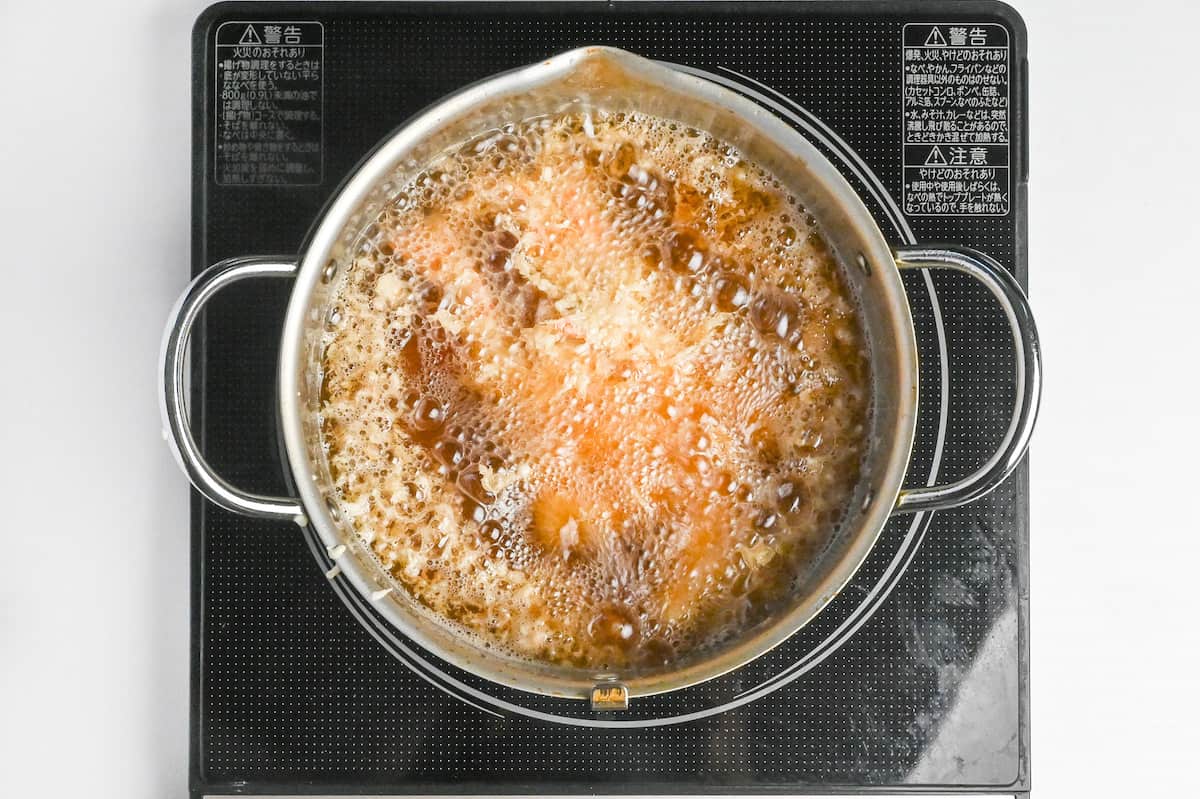
Test your oil with a drop of batter. If it sizzles and floats, you’re good to go. Lightly coat your ingredients in flour, dip them in the batter, and carefully lower them into the hot oil.
Fry until they’re crispy but not too golden. I find frying one type of ingredient at a time ensures even cooking.
If you make a big batch, drop in a couple of ice cubes to keep the batter cold.
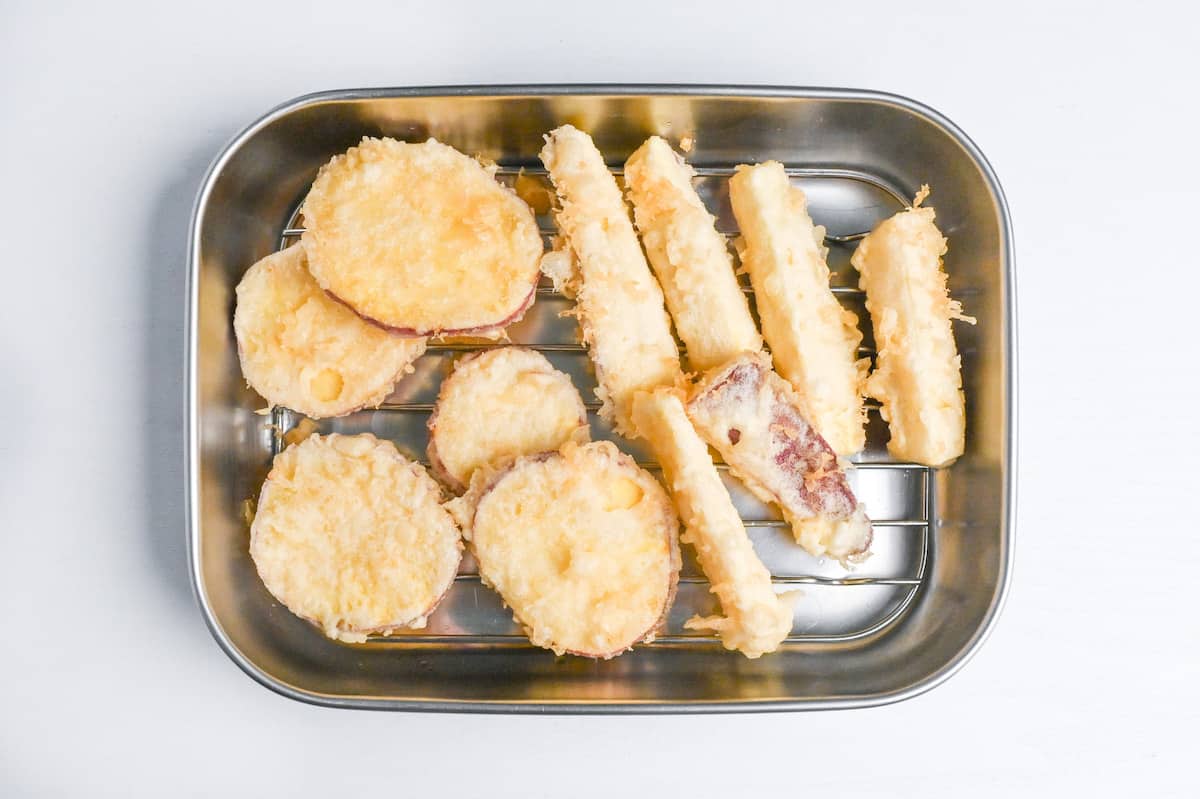
Once fried to perfection, transfer the tempura to a wire rack. This lets any extra oil drip away.
Now, all that’s left is to serve and enjoy with either salt or tempura dipping sauce!
Because precision and technicality are key in making authentic tempura batter, let’s go through all the dos and don’ts we discussed once again here:
Dos
- Use cake flour
- Sift flour
- Use icy cold water
- Remove foam from the whisked egg
- Leave some lumps
- Make the batter right before frying
Don’ts
- Use bread flour
- Leave the mixed batter out
- Use warm water
- Leave foam/bubbles in the whisked egg
- Overmix/Make it smooth
Extra Useful Tips & Tricks
- Use mayonnaise instead of egg if necessary: While I prefer using eggs for tempura batter, using mayonnaise as a substitute can be convenient for making small batches and avoiding leftovers. For small batches, mayonnaise is more manageable than measuring a fraction of an egg. Typically, one egg can be substituted with 1 tbsp of mayonnaise. But remember this only works with mayonnaise that contains eggs like Kewpie mayo.
- Dry and dust with flour: A common issue with tempura is the batter not sticking. To prevent this, dry the ingredients with a paper towel and coat them with a light flour layer before dipping them in the batter. This is especially crucial for shrimp and fish.
- Clean oil and make tenkasu: During tempura frying, bits often break off and float in the oil. To maintain oil quality, remove these bits with a fine mesh spoon between batches; otherwise, they can burn, making the oil bitter and discolored. These tempura flakes, called “tenkasu” (天かす), are useful. They can be used to top udon noodle soups or be used in dishes like devil’s onigiri. To make more tenkasu, drizzle the leftover batter into the oil. After frying, drain them on kitchen paper and store them in the freezer in a sealable freezer bag.
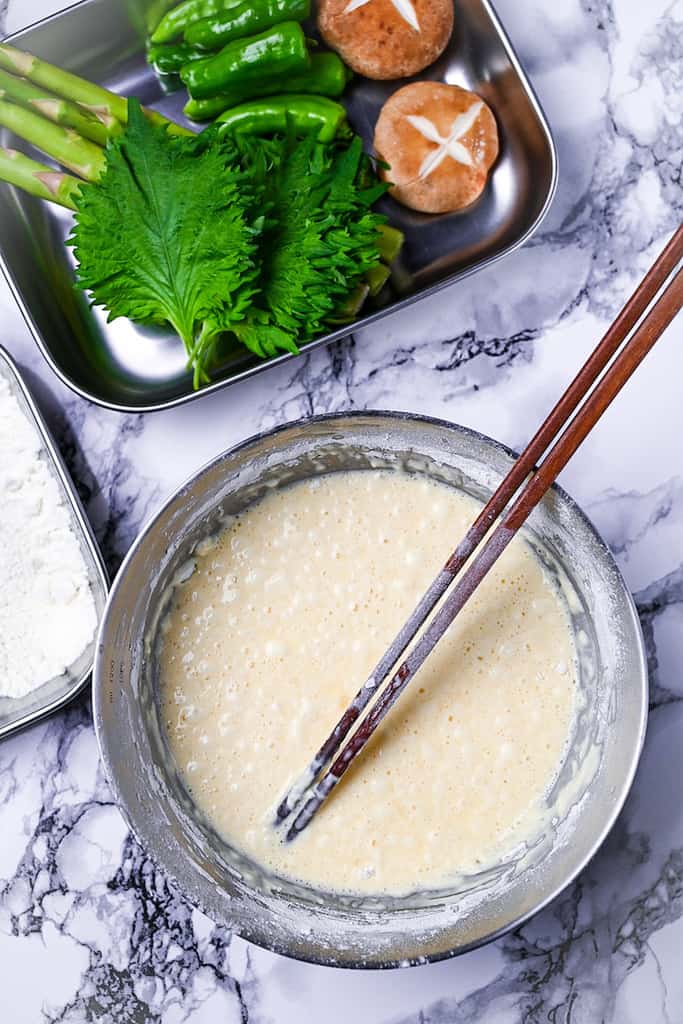
What to Eat with Tempura
When at home, we rarely eat tempura on its own. That only happens in expensive specialist tempura restaurants.
Here are a few examples of Japanese dishes that are served or made with tempura:
- Tendon (rice bowl with tempura)
- Tempura udon (udon noodles soup with tempura)
- Tempura soba (soba noodles soup with tempura)
- Zaru udon (cold udon)
- Zaru soba (cold soba)
- Tenjyu (Tempura on rice in a box)
- Tentoji (Tempura on rice with egg)
My personal favorite is zaru udon with tempura in summer! It’s the best!
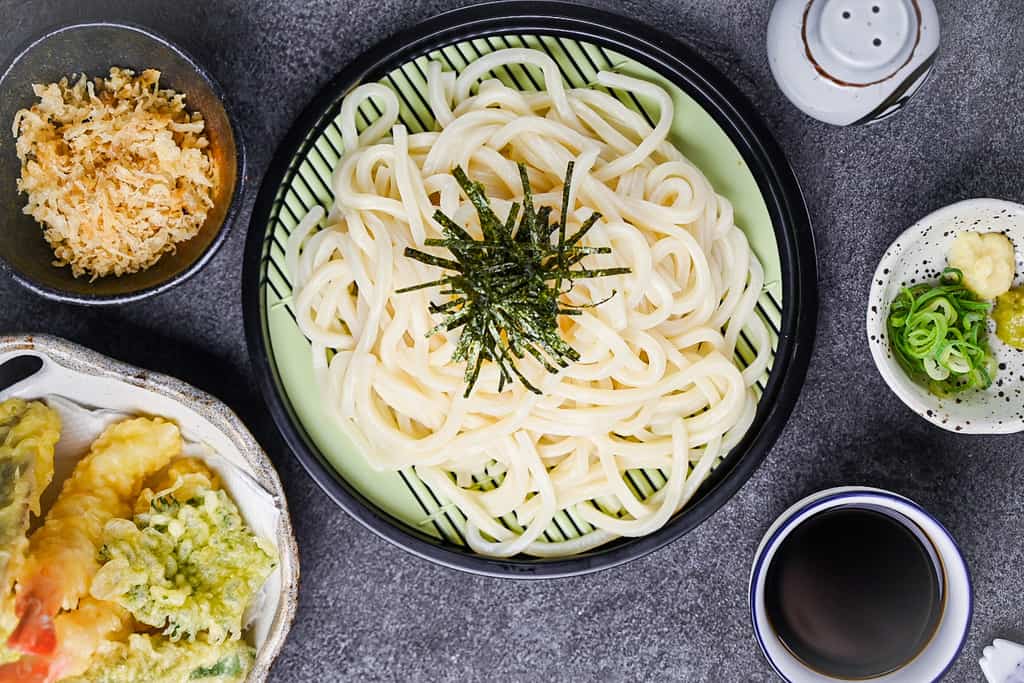
The Japanese Way to Eat Tempura
When it comes to eating tempura in Japan, there are several common ways to enjoy it.
Rather than eating it alone like a fritter, we typically dip it in a special tentsuyu sauce, eat it with salt (especially in high-end tempura restaurants), or drizzle it with a thick and sweet tendon sauce (for tendon).
The batter itself is lightly salted and not flavored in order to allow the unique flavor of each ingredient to shine through. This tempura batter recipe is made in a simple and authentic way, but it may not be suitable for certain dishes like rolled sushi or tenmusu due to the thin coating.
In Japan, sushi with tempura is usually served as nigiri sushi with the tempura on top of the rice, drizzled with a special sweet sauce.
If you want to use this recipe for sushi, nigiri style and sweet tempura sauce are a must. Tempura can also be used in other dishes such as tempura udon or tempura soba.
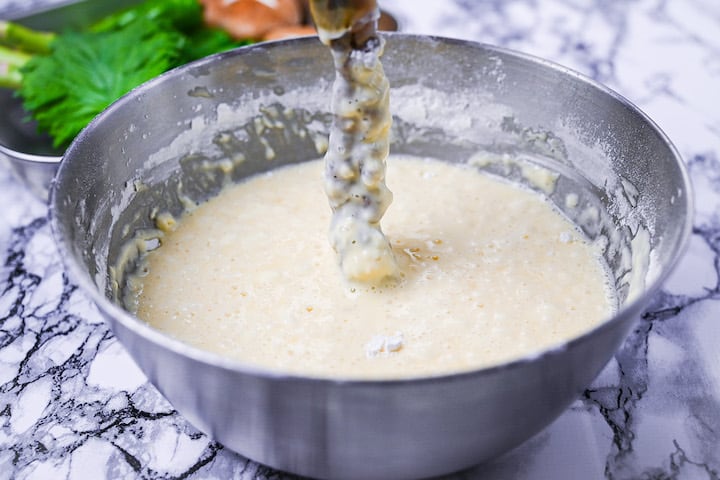
How to Cook Tempura Dishes by Ingredients
Despite what it seems, Japanese tempura is very delicate and hard to make perfect. Each ingredient requires a different temperature and preparation.
Sometimes, you may need to modify the batter slightly to ensure it turns out perfectly every time. In this section, I will provide you with specific processes and ideas for cooking tempura based on the ingredients you are using.
Please refer to the individual recipe below for precise cooking techniques, preparation, and time. I will continue to add more recipes for tempura and their cooking methods in the future.
- Chicken Tempura (Toriten): I understand many people may want to use this tempura batter for chicken, but I would not recommend it, especially for chicken breast. The reason is that this tempura batter is very thin, and the surface of the chicken breast is too smooth. For the best results in making chicken tempura, I suggest using my Toriten batter, specifically designed for regional chicken tempura and much easier to work with.
- Shrimp Tempura (Ebiten): Shrimp tempura is a popular Japanese dish of tender shrimp coated in a crispy batter. It can be enjoyed on its own or paired with other Japanese specialties such as tempura soba and udon. The main types of shrimp/prawns used in making tempura are Japanese Tiger Prawn, Black Tiger Prawn, and Whiteleg Shrimp.
- Eggplant Tempura: Eggplant, also known as “nasu” in Japan, is a great option for making tempura due to its vibrant purple skin and soft, juicy flesh. Its versatility in cutting and presentation methods allows for an impressive visual display. This recipe will guide you through three popular ways of serving eggplant tempura in Japan, helping you achieve a delicious combination of presentation and texture.
- Sweet Potato Tempura: Sweet potatoes are a delightful ingredient for tempura due to their charming reddish-purple skin, delectably sweet and creamy core, and versatile cutting and presentation possibilities. This sweet potato tempura recipe will guide you through three unique ways to cut and present sweet potato tempura, adding a dash of creativity to your culinary skills.
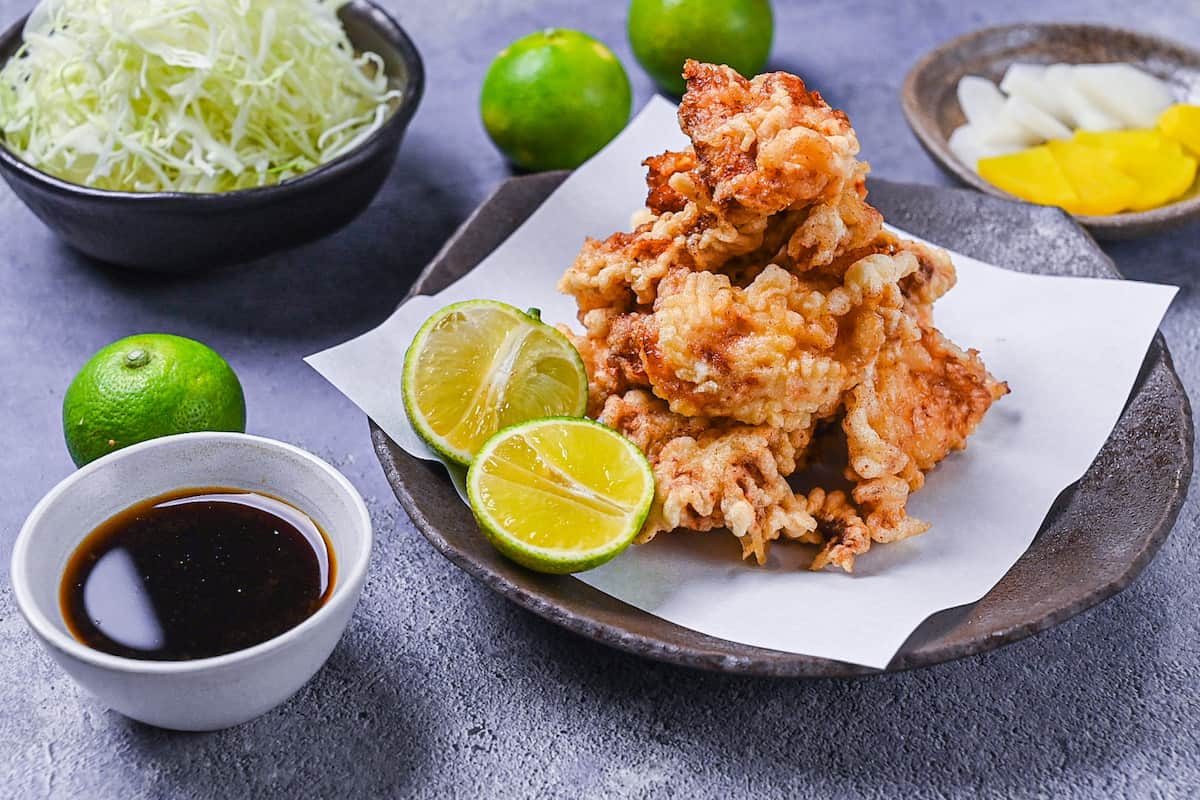
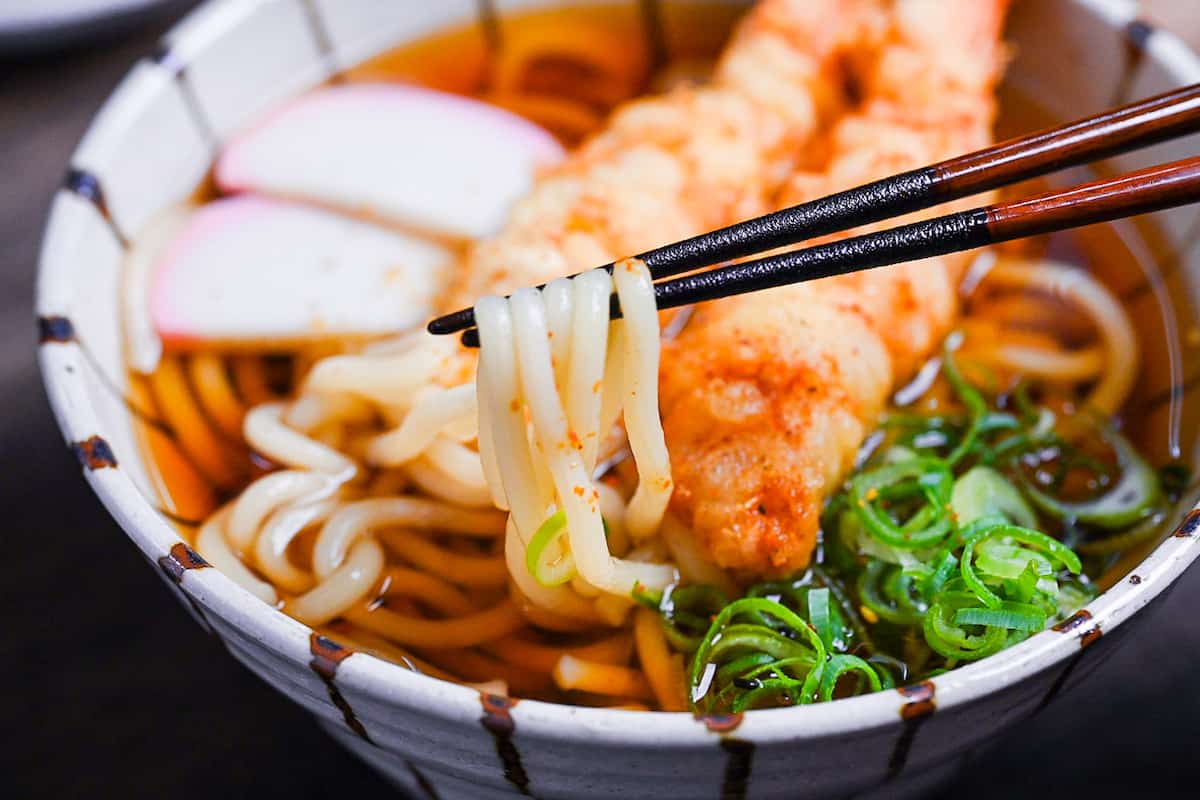
FAQ & Troubleshooting
You can use it with chicken thigh, but I do not recommend using it with chicken breast. This tempura batter is very thin, and the surface of the chicken breast is too smooth for it. For best results, I suggest using my toriten batter (regional chicken tempura) for any type of chicken.
Yes and no. This would not particularly be suitable if you’re thinking of using tempura in a rolled sushi (in fact, we rarely put tempura for rolled sushi in Japan). If you want to use it for rolled sushi, you would need thicker batter like ebi furai. However, if you put the tempura on top of rice (nigiri style), it will work and that’s how we usually combine tempura and sushi in Japan.
In Japan, tempura batter is intentionally plain. There are two reasons for this. Firstly, the batter is meant to be subtle so that the flavor of each ingredient can come through. Secondly, tempura is typically enjoyed with a dipping sauce or salt, depending on the restaurant. Some places serve it with a sweet sauce, such as on top of a tempura rice bowl. So, it’s normal for authentic tempura batter to be plain in taste.
Unfortunately not. Because this batter is thin, it is not suitable for air fryer cooking and you would need a tempura recipe specifically created for air fryer use.
The best temperature range for deep frying tempura is between 160°C (320°F) and 190°C (375°F). However, the exact temperature may vary depending on the type of ingredient used, its size, texture, and how it’s cut. I have created a guide for popular ingredients, which can be found above. Additionally, I will continue to add individual tempura recipes for more guidance. Please feel free to leave a comment below for additional advice.
I recommend either extra virgin (white) sesame oil or rice bran oil.
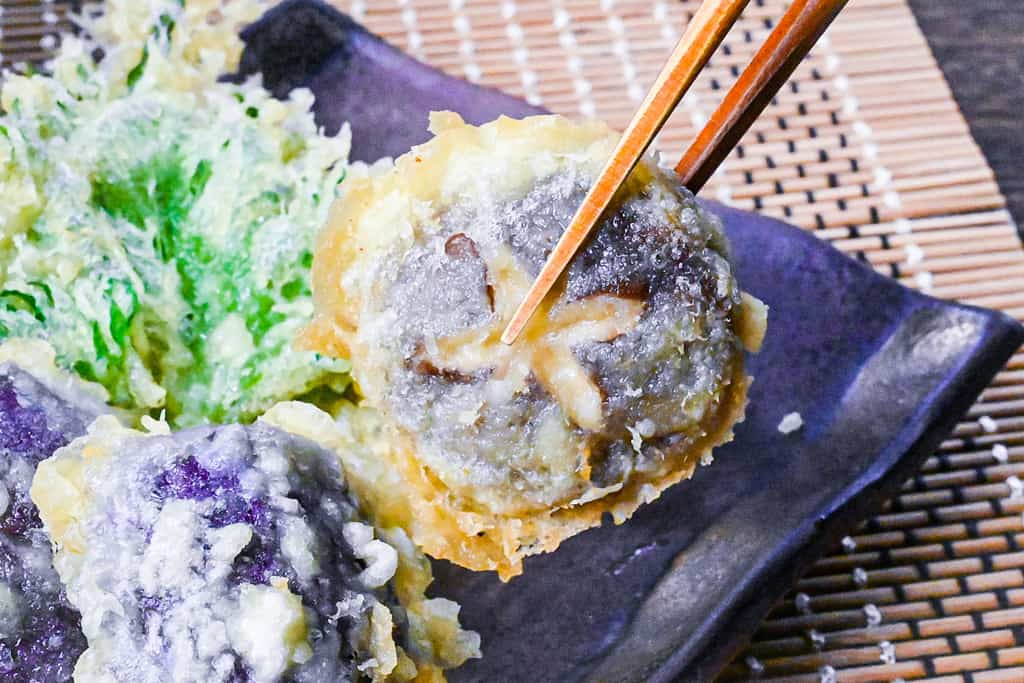
I hope you enjoy this Authentic Japanese Tempura Batter recipe! If you try it out, I’d really appreciate it if you could spare a moment to let me know what you thought by giving a review and star rating in the comments below. It’s also helpful to share any adjustments you made to the recipe with our other readers. Thank you!
More Japanese Deep-fried Recipes

Authentic Japanese Tempura Batter (with secret tips!)
Ingredients
- 150 ml cold water
- 100 ml soda water (or club soda)
- 30 g cornstarch
- 150 g cake flour
- 1 egg relatively small sized, chilled
- 3 ice cubes
- cooking oil for frying, vegetable, canola, peanut or white sesame
Instructions
- Measure out 150 ml cold water into a jug and place it in the fridge for 20-30 minutes. Place 100 ml soda water (or club soda) in the fridge too. (Preferably an unopened bottle.)

- Sift 30 g cornstarch and 150 g cake flour into a bowl. Mix them and place the bowl in the freezer for 20-30 minutes.

- While you wait for the water and flour to chill, prepare your tempura ingredients by washing, cutting, and drying them with kitchen paper to remove any excess moisture.

- Once 30 minutes have passed, start preheating your cooking oil to 180 °C (356 °F).

- Pour the chilled water and sparkling water into a bowl.

- Crack 1 egg into the bowl and whisk. (If bubbles or foam forms on top, scoop it out with a spoon.)

- Remove the chilled flour and starch mixture from the freezer. Add it to the egg mixture one third at a time, gently drawing crosses through with chopsticks to incorporate it. (Do not whisk or over mix, preventing gluten formation is key.)

- Add 3 ice cubes to the batter.

- Test your oil by adding a drop of batter, if it sizzles and floats you're ready to fry.Coat your ingredients in a thin layer of flour, brush off the excess and then dip them in the batter.

- Carefully place the battered ingredients straight into the oil and fry until crispy but before they turn golden. (I recommend frying one type of ingredient at a time to ensure even cooking.)

- Once cooked, place on a wire rack to allow the excess oil to drip off.

- Serve and enjoy!






Kasutera and pan also borrowed Portuguese.
That’s right!
Can I use rice flour (1:1) for this batter?
Hi Brian,
Thanks for your question. Yes you can! Rice flour is a popular choice for tempura 🙂
It was good, but I noticed that if I didn’t fry it to a light golden brown (not BEFORE) it lost its crispnese rather quickly (which wasn’t great because I was using tempura-fried items to add to a sushi roll) I fried them longer, and it definitely helped.
I also noted that it’s EXTREMELY bland. Maybe that’s why there needs to be a dipping sauce, but I’ve been to Japanese-run/owned restaurants in America and their batter isn’t this bland. I followed ALL the steps.
Hi Allison, thank you very much for your feedback!
Here are the answers to your comment:
1. We actually rarely add tempura to rolled sushi in Japan for this exact reason. But when we do, such as tenmusu (rice ball with shrimp tempura), a different type of batter is used. Thicker, fritter-like batters, flavoured batters or even breadcrumb coated ingredients like ebifry) are used. Sushi with tempura in Japan is usually nigiri sushi with the tempura served on top of rice (rather than rolled) with special sweet sauce so that the tempura stays crispy.
2. At least in Japan, tempura batter is normally bland/plain. There are two reasons for this. Firstly, we don’t want the batter to be overpowering, the goal is to allow the unique flavour of each ingredient to shine through. Secondly, as you rightly mentioned, tempura is not expected to be eaten as it is but rather dipped in a dipping sauce or dipped in salt (the high-end Japanese tempura restaurant way). It can also be served with special sweet sauce (e.g. tempura rice bowl).
Overall, thank you very much for pointing these things out, I will add more content to the post to make these clear for future readers.
Best wishes,
Yuto
what will happen if i pour the water on the flour instead of add flour to water?
Since lumps are fine in this recipe, it’s okay to pour it onto the flour, but you need to whisk the egg into the water first.
Have you tried this recipe using an air fryer? Would really appreciate the process required using an air fryer.
Hi Cliff, because this batter is thin, it is not suitable for air fryer cooking and you would need a tempura recipe specifically created for air fryer use. I don’t have an air fryer myself so it’s not something I can develop here at this time. Sorry I couldn’t be of more help and I hope you find what you’re looking for!
Yes! Finally a recipe that cools all the ingredients. I thought I was crazy to do that. Thanks for the weights. This is now my recipe! Cheers.
Hi Bobby,
Haha well if it’s crazy then I’m crazy too!
Thanks so much for the comment and 5 star review.
This did not work.. the temp of the oil was just too low – especially when adding cold items to the oil – which brought the oil temp down even more. Did I miss something – pre-cooking the veggies maybe?
Hi Ann, I’m sorry to hear it didn’t work for you. What went wrong exactly? The batter didn’t stick? The vegetables weren’t cooked?
The oil should be preheated to 180°C (355°F). Tempura fries best between 160-180°C so by heating it to the higher end, this should accommodate for the cold items bringing the temperature down slightly, then the temperature should go back up as it cooks.
I’m not too sure why it didn’t work for you (I’ve used this recipe many times and haven’t had that problem). My only advice for problems with oil temperature is to use a thermometer for accuracy and fry in small batches, frying too many things at once can bring the temperature down too much.
What vegetables did you use? You don’t need to pre-cook the vegetables, cutting them small or thin should be enough. Thank you for your feedback, I’ll update the post with more advice on how to perfectly cut and cook the most commonly used vegetables. Hope this helps!
Hi Yuto, thanks for the recipe! Was really just looking to confirm quantities cuz usually eyeball it, but your tips and additions are very helpful! Mom, who’s Japanese, only used iced water, flour, and egg, mixed gently with ohashi, and an electric wok. Don’t have sparkling water to try (will try next time), but will be trying the corn starch, using mayo instead of egg for our small batch, and coating with flour before battering. Also using a little bottle of dipping sauce that someone gave me – ran out of mirin so it’s a good excuse to be lazy and finally see how that sauce in a bottle is. Since it’s a small batch, will get to try out the deep fryer instead of the usual electric wok. We’re having a late snack of broccoli and onion tempura with rice tonight! BBL… Oishi! Love the corn starch addition, and the batter stuck perfectly to the onion slices as promised! Hubs wants more! Think the electric wok is better. Bottled sauce was ok, but will stick to Mom’s sauce. Thanks again!
Hi Miyuki.
Thank you for trying the recipe and sharing your experience. The mayo trick is great for small batches isn’t it?
Glad to hear you and your husband enjoyed the recipe, thanks again!
Awesome recipe! Used a flax egg instead of real egg (egg allergy in our house) and had low expectations— but it was great! Still super light and crisp. Highly recommend if you also need eggless recipes 🙂
Hi Kate,
Thank you for the comment! I’m glad this recipe still worked well with an egg alternative! 🙂
Yuto
Thanks for this delicious Tempura recipe.
It’s absolutely super!
Hi Thomas,
Thank you for your comment and feedback! I’m happy to hear that you enjoyed the recipe! 🙂
Yuto
Thank you! This was my first try at making tempura and it was a success! The first few things in the pan were under-cooked or over-cooked, but it was a fairly short learning curve. The batter worked well once I got the timing right. I look forward to trying this again. It wasn’t nearly as difficult as I had imagined it would be.
Hi Alice,
Thank you for your comment!
I’m glad to hear it turned out great. I’m looking forward to hearing about your next tempura fry-up too! 🙂
Yuto
thank you so much for sharing
Thank you!